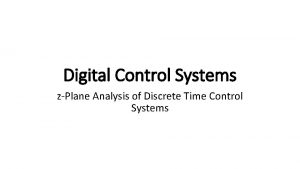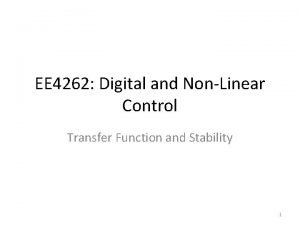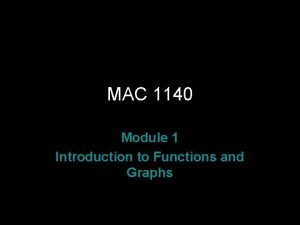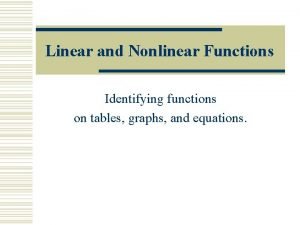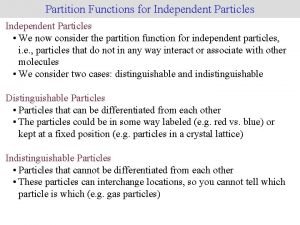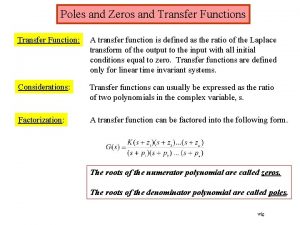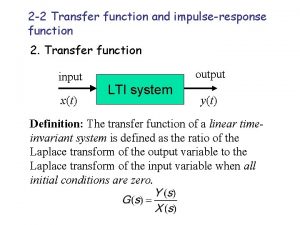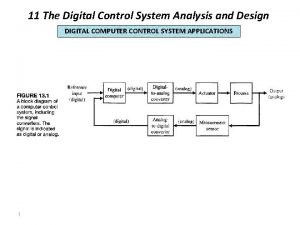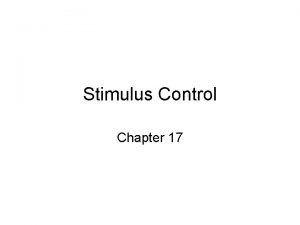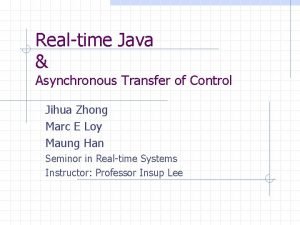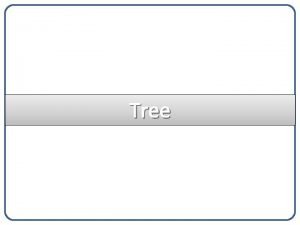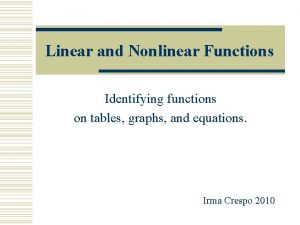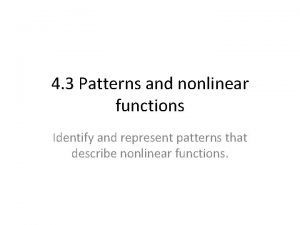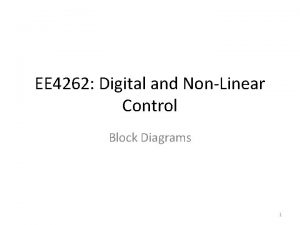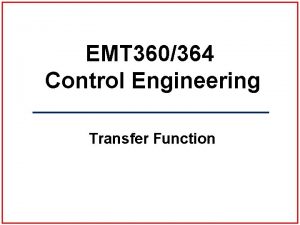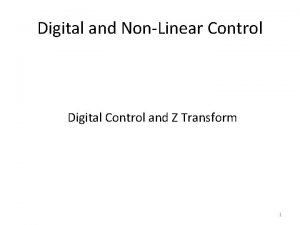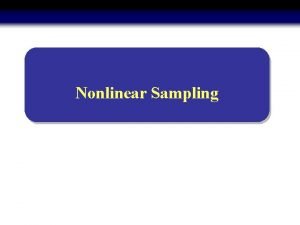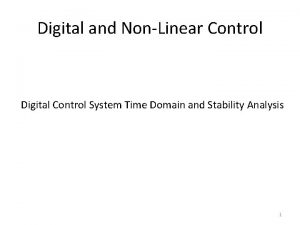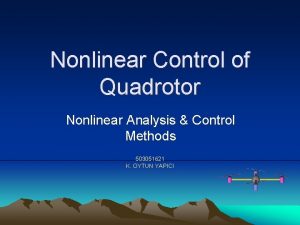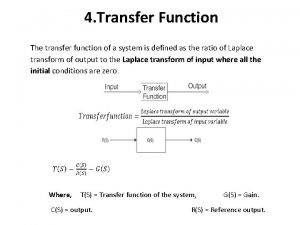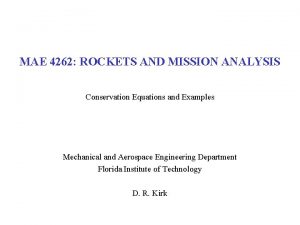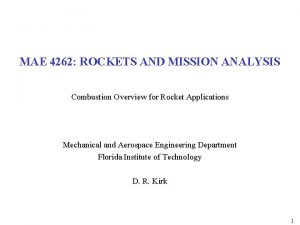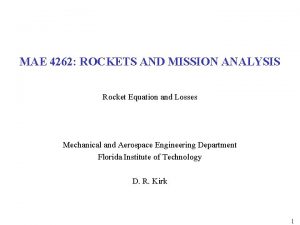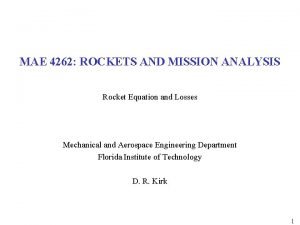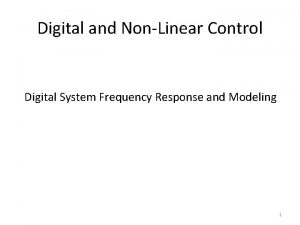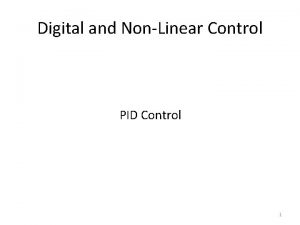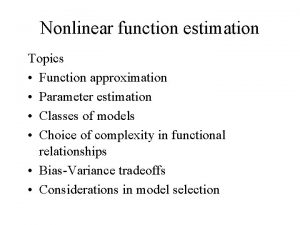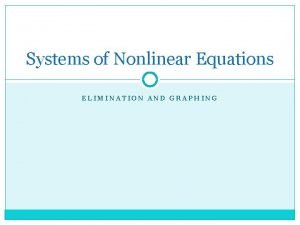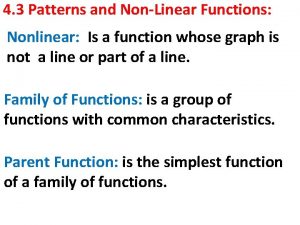EE 4262 Digital and NonLinear Control Transfer Function































- Slides: 31

EE 4262: Digital and Non-Linear Control Transfer Function and Stability 1

Transfer Function • Transfer Function is the ratio of Laplace transform of the output to the Laplace transform of the input. Consider all initial conditions to zero. u(t) Plant y(t) • Where is the Laplace operator. 2

Transfer Function • The transfer function G(S) of the plant is given as U(S) G(S) Y(S) 3

Why Laplace Transform? • Using Laplace transform, we can convert many common functions into algebraic function of complex variable s. • For example • Where s is a complex variable (complex frequency) and is given as 4

Laplace Transform of Derivatives • Not only common function can be converted into simple algebraic expressions but calculus operations can also be converted into algebraic expressions. • For example 5

Laplace Transform of Derivatives • In general • Where is the initial condition of the system. 6

Laplace Transform of Integrals • The time domain integral becomes division by s in frequency domain. 7

Calculation of the Transfer Function • Consider the following ODE where y(t) is input of the system and x(t) is the output. • or • Taking the Laplace transform on either sides 8

Calculation of the Transfer Function • Considering Initial conditions to zero in order to find the transfer function of the system • Rearranging the above equation 9

Transfer Function • In general • Where x is the input of the system and y is the output of the system. 10

Transfer Function • When order of the denominator polynomial is greater than the numerator polynomial the transfer function is said to be ‘proper’. • Otherwise ‘improper’ 11

Transfer Function • Transfer function can be used to check – The stability of the system – Time domain and frequency domain characteristics of the system – Response of the system for any given input 12

Stability of Control System • There are several meanings of stability, in general there are two kinds of stability definitions in control system study. – Absolute Stability – Relative Stability 13

Stability of Control System • Roots of denominator polynomial of a transfer function are called ‘poles’. • The roots of numerator polynomials of a transfer function are called ‘zeros’. 14

Stability of Control System • Poles of the system are represented by ‘x’ and zeros of the system are represented by ‘o’. • System order is always equal to number of poles of the transfer function. • Following transfer function represents nth order plant (i. e. , any physical object). 15

Stability of Control System • Poles is also defined as “it is the frequency at which system becomes infinite”. Hence the name pole where field is infinite. • Zero is the frequency at which system becomes 0. 16

Stability of Control System • Poles is also defined as “it is the frequency at which system becomes infinite”. • Like a magnetic pole or black hole. 17

Relation b/w poles and zeros and frequency response of the system • The relationship between poles and zeros and the frequency response of a system comes alive with this 3 D pole-zero plot. Single pole system 18

Example • Consider the Transfer function calculated in previous slides. • The only pole of the system is 19

Examples • Consider the following transfer functions. – Determine • • Whether the transfer function is proper or improper Poles of the system zeros of the system Order of the system i) iii) iv) 20

Stability of Control Systems • The poles and zeros of the system are plotted in s-plane to check the stability of the system. LHP RHP s-plane 21

Stability of Control Systems • If all the poles of the system lie in left half plane the system is said to be Stable. • If any of the poles lie in right half plane the system is said to be unstable. • If pole(s) lie on imaginary axis the system is said to be marginally stable. LHP RHP s-plane 22

Stability of Control Systems • For example • Then the only pole of the system lie at LHP RHP X -3 s-plane 23

Examples • Consider the following transfer functions. § § § Determine whether the transfer function is proper or improper Calculate the Poles and zeros of the system Determine the order of the system Draw the pole-zero map Determine the Stability of the system i) iii) iv) 24

The Other Definition of Stability • The system is said to be stable if for any bounded input the output of the system is also bounded (BIBO). • Thus for any bounded input the output either remain constant or decrease with time. overshoot u(t) y(t) 1 t Unit Step Input Plant 1 t Output 25

The Other Definition of Stability • If for any bounded input the output is not bounded the system is said to be unstable. u(t) y(t) 1 t Unit Step Input Plant t Output 26

BIBO vs Transfer Function • For example stable unstable

BIBO vs Transfer Function • For example

BIBO vs Transfer Function • For example

BIBO vs Transfer Function • Whenever one or more than one poles are in RHP the solution of dynamic equations contains increasing exponential terms. • That makes the response of the system unbounded and hence the overall response of the system is unstable.

Summary • • • Transfer Function The Order of Control Systems Poles, Zeros Stability BIBO 31
 Zero order hold laplace
Zero order hold laplace Nuuee
Nuuee Transfer function
Transfer function Nonlinear table
Nonlinear table Non linear pipeline processors
Non linear pipeline processors Nonlinear function table
Nonlinear function table Linear and nonlinear table
Linear and nonlinear table Materi fungsi non linier
Materi fungsi non linier Relation between partition function and internal energy
Relation between partition function and internal energy A wave is a disturbance that transfers energy
A wave is a disturbance that transfers energy Poles and zeros of transfer function
Poles and zeros of transfer function Impulse input
Impulse input Digital market and digital goods
Digital market and digital goods Digital control system application
Digital control system application S domain
S domain Introduction to digital control
Introduction to digital control Stimulus shape transformation example
Stimulus shape transformation example Asynchronous transfer of control
Asynchronous transfer of control Linear and nonlinear data structure
Linear and nonlinear data structure Linear and nonlinear editing
Linear and nonlinear editing Linear and nonlinear data structure
Linear and nonlinear data structure Linear vs nonlinear text
Linear vs nonlinear text Identifying linear functions worksheet
Identifying linear functions worksheet Example of non linear multimedia
Example of non linear multimedia Non linear literature
Non linear literature Linear and nonlinear relationships
Linear and nonlinear relationships Difference between linear and nonlinear spatial filters
Difference between linear and nonlinear spatial filters Difference between linear and nonlinear
Difference between linear and nonlinear Linear and nonlinear multimedia
Linear and nonlinear multimedia 4-3 practice patterns and nonlinear functions
4-3 practice patterns and nonlinear functions Linear and nonlinear equations worksheet
Linear and nonlinear equations worksheet Product and process control
Product and process control
